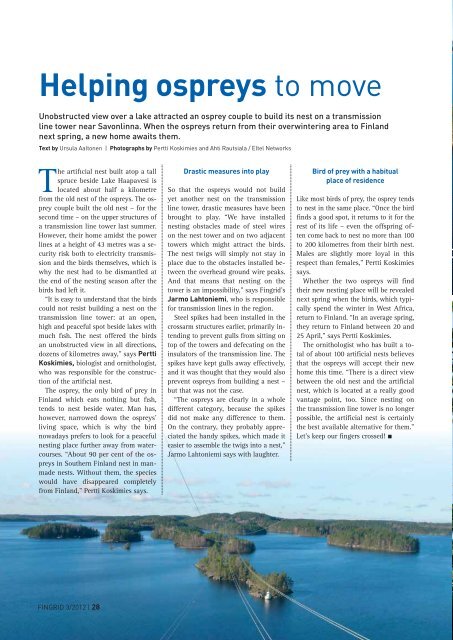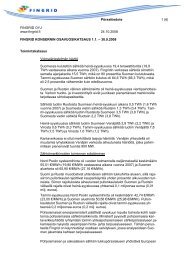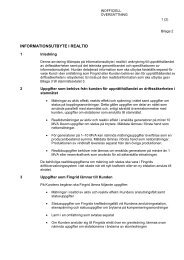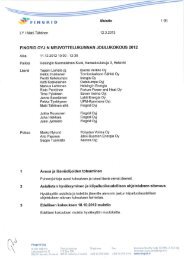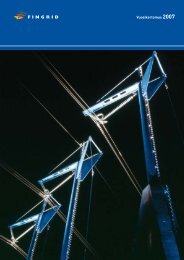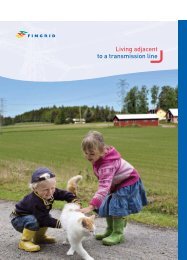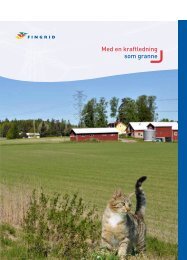3/2012 - Fingrid
3/2012 - Fingrid
3/2012 - Fingrid
You also want an ePaper? Increase the reach of your titles
YUMPU automatically turns print PDFs into web optimized ePapers that Google loves.
Helping ospreys to move<br />
Unobstructed view over a lake attracted an osprey couple to build its nest on a transmission<br />
line tower near Savonlinna. When the ospreys return from their overwintering area to Finland<br />
next spring, a new home awaits them.<br />
Text by Ursula Aaltonen | Photographs by Pertti Koskimies and Ahti Rautsiala / Eltel Networks<br />
The artificial nest built atop a tall<br />
spruce beside Lake Haapavesi is<br />
located about half a kilometre<br />
from the old nest of the ospreys. The osprey<br />
couple built the old nest – for the<br />
second time – on the upper structures of<br />
a transmission line tower last summer.<br />
However, their home amidst the power<br />
lines at a height of 43 metres was a security<br />
risk both to electricity transmission<br />
and the birds themselves, which is<br />
why the nest had to be dismantled at<br />
the end of the nesting season after the<br />
birds had left it.<br />
“It is easy to understand that the birds<br />
could not resist building a nest on the<br />
transmission line tower: at an open,<br />
high and peaceful spot beside lakes with<br />
much fish. The nest offered the birds<br />
an unobstructed view in all directions,<br />
dozens of kilometres away,” says Pertti<br />
Koskimies, biologist and ornithologist,<br />
who was responsible for the construction<br />
of the artificial nest.<br />
The osprey, the only bird of prey in<br />
Finland which eats nothing but fish,<br />
tends to nest beside water. Man has,<br />
however, narrowed down the ospreys’<br />
living space, which is why the bird<br />
nowadays prefers to look for a peaceful<br />
nesting place further away from watercourses.<br />
“About 90 per cent of the ospreys<br />
in Southern Finland nest in manmade<br />
nests. Without them, the species<br />
would have disappeared completely<br />
from Finland,” Pertti Koskimies says.<br />
Drastic measures into play<br />
So that the ospreys would not build<br />
yet another nest on the transmission<br />
line tower, drastic measures have been<br />
brought to play. “We have installed<br />
nesting obstacles made of steel wires<br />
on the nest tower and on two adjacent<br />
towers which might attract the birds.<br />
The nest twigs will simply not stay in<br />
place due to the obstacles installed between<br />
the overhead ground wire peaks.<br />
And that means that nesting on the<br />
tower is an impossibility,” says <strong>Fingrid</strong>’s<br />
Jarmo Lahtoniemi, who is responsible<br />
for transmission lines in the region.<br />
Steel spikes had been installed in the<br />
crossarm structures earlier, primarily intending<br />
to prevent gulls from sitting on<br />
top of the towers and defecating on the<br />
insulators of the transmission line. The<br />
spikes have kept gulls away effectively,<br />
and it was thought that they would also<br />
prevent ospreys from building a nest –<br />
but that was not the case.<br />
“The ospreys are clearly in a whole<br />
different category, because the spikes<br />
did not make any difference to them.<br />
On the contrary, they probably appreciated<br />
the handy spikes, which made it<br />
easier to assemble the twigs into a nest,”<br />
Jarmo Lahtoniemi says with laughter.<br />
Bird of prey with a habitual<br />
place of residence<br />
Like most birds of prey, the osprey tends<br />
to nest in the same place. “Once the bird<br />
finds a good spot, it returns to it for the<br />
rest of its life – even the offspring often<br />
come back to nest no more than 100<br />
to 200 kilometres from their birth nest.<br />
Males are slightly more loyal in this<br />
respect than females,” Pertti Koskimies<br />
says.<br />
Whether the two ospreys will find<br />
their new nesting place will be revealed<br />
next spring when the birds, which typically<br />
spend the winter in West Africa,<br />
return to Finland. “In an average spring,<br />
they return to Finland between 20 and<br />
25 April,” says Pertti Koskimies.<br />
The ornithologist who has built a total<br />
of about 100 artificial nests believes<br />
that the ospreys will accept their new<br />
home this time. “There is a direct view<br />
between the old nest and the artificial<br />
nest, which is located at a really good<br />
vantage point, too. Since nesting on<br />
the transmission line tower is no longer<br />
possible, the artificial nest is certainly<br />
the best available alternative for them.”<br />
Let’s keep our fingers crossed! <br />
FINGRID 3/<strong>2012</strong> | 28


